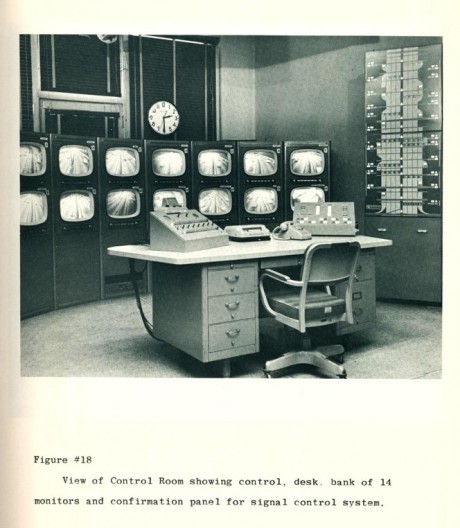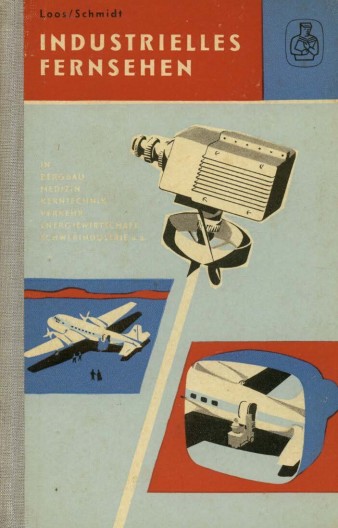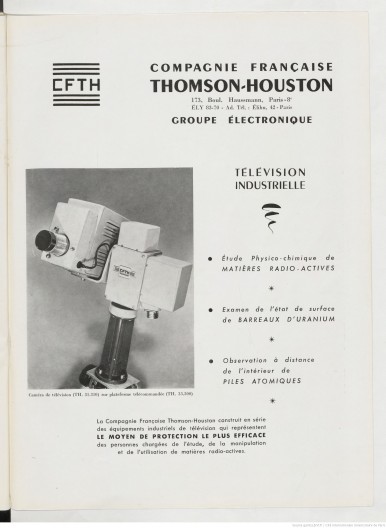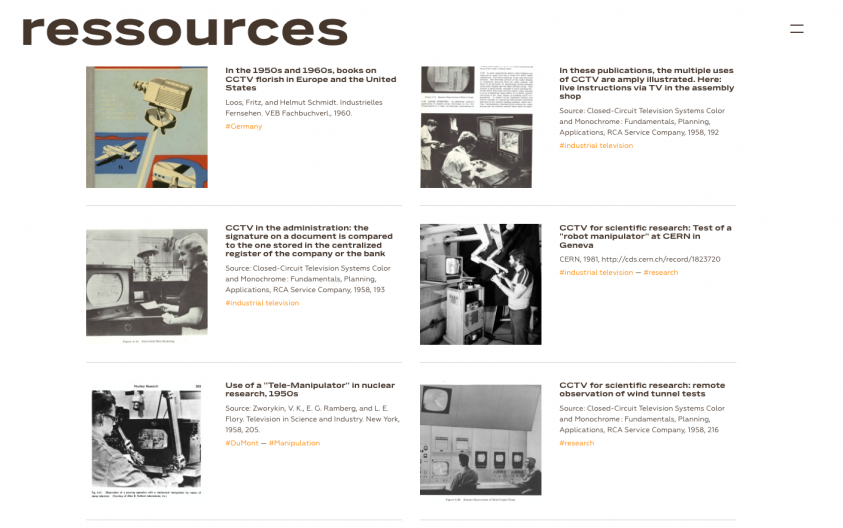The Dronetv.lu website is an extension of my postdoctoral research project supported by the Swiss National Science Foundation, for which I spent one year as a Visiting Researcher at the C²DH. The website's development and online publication was made possible thanks to the support by the C²DH.
Towards a History of CCTV
Television’s history has predominantly been told from the perspective of its broadcasting institutions and domestic practices; the bulk of television scholarship traces the story of a mass medium. Doing so, it neglects a parallel history of “useful television”, built upon a visual closed circuit, the miniaturization of machines, small-scale audiences, and alleged universal operability. Distributed under the name of Industrial Television and CCTV (for closed circuit television), this prevalent but overlooked form of televisuality was developed for military uses during World War II before it was adapted to industrial, commercial, educational, and bureaucratic spaces.
Dronetv.lu investigates the visual, material, and epistemic dimensions of this televisual form defined in terms of audiovisual instrumentality and operability, and running in multiple spaces outside the home. It takes advantage of the blog format to publish short case studies based on archival sources, and to cartography so far uncharted territory of televisual operations.
In addition to the original research papers and other contributions, the website contains a bibliography on the history of CCTV, as well as a database, giving access to the documents discussed in the various blog posts. Although very simple, this archive-oriented “resource” page gives an insight into the plurality and diversity of CCTV applications – and their historical traces. As these sources shows, the uses of CCTV in warfare, industry, science, and education were far-reaching and multifaceted: closed-circuit images were more than a footnote in TV’s overall history.
The Making Of
Dronetv.lu is partly the result of pandemic circumstances. It brings together contributions by BA-students of the Seminar für Medienwissenschaft at the University of Basel, with whom I had the pleasure to work during the fall semester 2020; it furthermore includes my own research.
Its objectives are twofold.
First, it serves as a showcase of my ongoing research project Operative TV. Closed-Circuit Images from WWII to the Cold War, for which I just have received a NOMIS-Fellowship at eikones. Center for the theory and history of images at the University of Basel. This project aims at bringing to the fore the largely neglected history of closed-circuit television and its virtually universal applications. In this regard, the website continues to be nourished in the following months.
Second, Dronetv.lu has served as a tool for teaching during the COVID- Pandemic and may continue to serve as a teaching platform in the future. Instead of following online-seminars and zoom-lectures, the BA-students have collaborated on historical case studies on CCTV. For many of the students, the writing and publishing in an online outlet has been a new experience, as was the work with historical sources. They addressed the different challenges with determination, despite the difficult circumstances of socially distant learning, cooperating, and researching.
The seminar was organized as a research seminar, which required autonomy and curiosity from the students, and the willingness to engage in largely unknown topics. After a first few “regular” meetings, during which we discussed historical and methodological framings, the students started working on their own projects in small groups. To do so, they had received an outline of their chosen topic, a list with secondary literature, as well as the relevant sources. In “normal” times I would have suggested to visit archival centers with interested students in order to give them an insight into archival work and to communicate “le goût de l’archive”. With the pandemic and the general closure of archival institutions, we used materials I had collected beforehand.
From my perspective as a teacher, the project-based group work replacing synchronous or asynchronous online teaching with the full class had a few notable advantages, including, among others, the possibility to get to know the students, since the discussions were mainly held in small groups of 4 to 5. The individual group support provided the satisfaction to be able to follow closely the different projects, the students’ questions as well as their progress.
Furthermore, in small group settings, the students’ pandemic-related needs such as greater flexibility in their schedule or the necessity to “small-talk” with colleagues in absence of the coffee machine talk, could be taken into consideration.
From the perspective of the students, the project-based group work also received broad approval, although some of the students highlighted the additional workload included in the preparation of a published blog post, rather than a seminar paper read only by the teacher and a few colleagues.
Spotlighting the History of Contemporary Practices
Although not initially planned as a “pandemic project”, the website dronetv.lu offered a particularly suitable tool for teaching during an online-semester, providing the students with the opportunity to dig into a largely forgotten strand of television history, but also to gain experience with online-publishing. In addition, the topic itself greatly nourished our reflection on the current situation. Indeed, the growth of different forms of public health surveillance, but also the massive development of videoconferencing through platforms such as Zoom, and more broadly the use of audiovisual tools for learning and teaching are all linked to the histories of useful television we researched during our seminar.
The contributions reunited on dronetv.lu spotlight the historical conditions and genealogies of contemporary practices with useful media, many of which we seldomly reflect upon. In a sense, then, the seminar responded to one of the calls by media scholars who highlighted the importance to “to question current developments in teaching and learning as well as their medial conditions” (Bohnenkamp et al. 2020). The use of Zoom for our meetings, but for instance also the non-use of public transportation (as one of the sites where CCTV surveillance is widespread) allowed to connect our daily experiences with the home office and pandemic related isolation with the seminar’s research topic. Indeed, the COVID-19 pandemic has only reinforced the presence of closed-circuit images in our daily lives: bringing to the fore the predigital development of these current trends, the student projects intervene in ongoing debates related to questions of surveillance and privacy, learning at a distance, or telemedicine. Overall, the research on CCTV connects the history of an electronic medium with transformations we usually link to the so-called “digital revolution”, producing new insights into the pasts of our digital present.
I wish to thank the C²DH, and in particular Andreas Fickers, Brigitte Melchior-Dolenc and Sofia Magalhaes for their support.
A special thank also to all the students who have contributed to this project:
Daorsa Badivuku; Florian Bayer; Laura Brücker; Catherine Csebits; Paola D'Arcangelo; Jeffrey Gnehm; Seraina Julia Graf; Philipp Haller; Jonas Hochberg; Gökçe Kaya; Vanessa Klein; Viviane Kübler; Vera Leuenberger; Isabella Margjini; Michelle Meier; Samuel Müller; Melina Mundschin; Nicolas Neuenschwander; Flurina Sara Perrez; Lara Petralli; Eleonora Ponti; Emeline Samson; Martin Schäffler; Nathalie Schwab; Enis Shatrolli; Mia Carina Stauffacher; Gizem Topcuoglu; Gernot Vlcek; Remo Weber; Mathias Stefan Wey.








